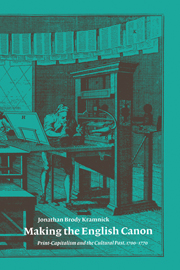Introduction: the modernity of the past
Published online by Cambridge University Press: 22 September 2009
Summary
The English literary canon achieved its definitive shape during the middle decades of the eighteenth century. The idea of national tradition to which we have given a final burial was born at that time from debates over the past. Eighteenth-century literary critics looked to older works in response to a prolonged and pronounced transformation: the opening of the cultural product for a nation of readers. What we have learned to call “the canon” – a pantheon of high-cultural works from the past – came into beingas a contradiction. Modernity generates tradition. The swelling of the book trade, the passing of aristocratic authority, the rise in literacy, the prominence of women writers and readers, the professionalization of criticism, together provoked over the course of the century a recourse to older works as national heritage. Canon formation, then as now, partook in wide-ranging debates about the nature of the cultural community. Critics weighed the value of older works and pondered their relation to modern writing. They also contemplated the character of modern readers, and examined how the education, class, and gender of the reading audience had changed over time. The paradoxical establishment of tradition out of a sense of modernity happened when literary culture was seen to be under considerable duress, even in crisis. Whereas the new literary and social world was unpredictable, and readers and genres no longer conformed to a settled pattern, works written before the onset of cultural modernity exhibited a contrasting splendor.
- Type
- Chapter
- Information
- Making the English CanonPrint-Capitalism and the Cultural Past, 1700–1770, pp. 1 - 12Publisher: Cambridge University PressPrint publication year: 1999

